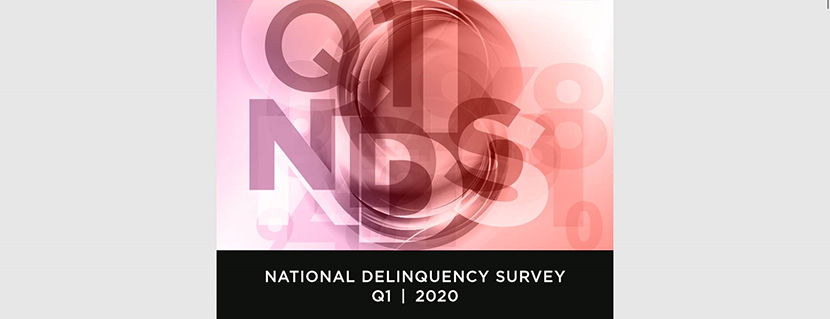
MBA Reports Rise in 1st Quarter Mortgage Delinquencies

Mortgage delinquencies rose in the first quarter as the economic effects of the coronavirus pandemic began to take hold, the Mortgage Bankers Association reported this morning.
The quarterly MBA National Delinquency Survey said the delinquency rate for mortgage loans on one-to-four-unit residential properties increased to a seasonally adjusted rate of 4.36 percent of all loans outstanding at the end of the first quarter, up 59 basis points from the fourth quarter but down 6 basis points from one year ago. The percentage of loans on which foreclosure actions were started in the first quarter fell by 2 basis points to 0.19 percent.

“The mortgage delinquency rate in the fourth quarter was at its lowest rate since MBA’s survey began in 1979. Fast-forward to the end of March, and it is clear the COVID-19 pandemic is impacting the market,” said Marina Walsh, MBA Vice President of Industry Analysis.
Walsh said the jump in first quarter delinquencies was reminiscent of the hurricane-related, 64-basis-point increase seen in third quarter. “The major variances from the fourth quarter of 2019 to this year’s first quarter are tied to the increase in early-stage delinquencies for all loan types,” she said.
MBA reported the seriously delinquent rate in the first quarter decreased by 9 basis points and was down 29 basis points from a year ago. The foreclosure inventory rate – the percentage of loans in the foreclosure process – was at its lowest level last quarter since 1984. Foreclosure starts were down 2 basis points from the previous quarter.
“Mortgage delinquencies track closely with the U.S. job market,” Walsh said. “With unemployment rising from historical lows in early 2020 to a record 14.7 percent in April, it is inevitable that mortgage delinquencies would increase as well–33.5 million U.S. workers applied for unemployment benefits in the past seven weeks, and with signs of economic distress continuing into the second quarter, mortgage delinquencies will likely further increase.”
Walsh noted a possible flattening in foreclosure starts in future quarterly surveys due to COVID-19-related foreclosure moratoria and borrower forbearance guidelines under the CARES Act. She said nearly four million homeowners are on forbearance plans as of May 3, but MBA’s survey asks servicers to report these loans as delinquent if the payment was not made based on the original terms of the mortgage – in the same manner that delinquency data is collected during natural disasters.
“Once foreclosure moratoria are lifted and forbearance periods end, borrower repayment and modification options, combined with year-over-year equity accumulation and home-price gains, may present alternatives to foreclosure for the millions of distressed homeowners affected by this unfortunate pandemic and economic crisis,” Walsh said.
Other key survey findings:
–Compared to the fourth quarter, the seasonally adjusted mortgage delinquency rate increased for all loans outstanding. By stage, the 30-day delinquency rate rose to 2.67 percent, a 50-basis-point increase that matches third quarter 2017 as the highest quarterly increase in the NDS series dating back to 1979. The 60-day delinquency rate increased 7 basis points to 0.77 percent, while the 90-day or more past due delinquency bucket increased 3 basis points to 0.93 percent.
–By loan type, the seasonally adjusted 30-day delinquency rate for conventional loans increased 30 basis points to 1.90 percent over the previous quarter. The FHA 30-day delinquency rate increased 113 basis points to 6.09 percent. The VA 30-day delinquency rate increased 78 basis points to 2.81 percent over the previous quarter.
–By loan type, the total delinquency rate (which includes 30-day, 60-day and 90-day or more past due) for conventional loans increased 34 basis points to 3.16 percent over the previous quarter. The FHA delinquency rate increased 131 basis points to 9.69 percent, the highest level since the fourth quarter of 2017. The VA delinquency rate increased by 101 basis points to 4.65 percent over the previous quarter, the highest level since first quarter 2015.
–On a year-over-year basis, overall mortgage delinquencies decreased for total loans outstanding. However, there were differences by loan type. The delinquency rate decreased by 30 basis points for conventional loans, increased 76 basis points for FHA loans, and increased 28 basis points for VA loans from the previous year.
–The delinquency rate includes loans that are at least one payment past due but does not include loans in the process of foreclosure. The percentage of loans in the foreclosure process at the end of the first quarter was 0.73 percent, down 5 basis points from the fourth quarter of 2019 and 19 basis points lower than one year ago. This is the lowest foreclosure inventory rate since 1984.
–The seriously delinquent rate—the percentage of loans that are 90 days or more past due or in the process of foreclosure—fell to 1.67 percent – a decrease of 9 basis points from last quarter – and a decrease of 29 basis points from last year. The seriously delinquent rate decreased 7 basis points for conventional loans, decreased 18 basis points for FHA loans, and decreased 12 basis points for VA loans from the previous quarter. Compared to a year ago, the seriously delinquent rate decreased by 35 basis points for conventional loans, decreased 16 basis points for FHA loans, and decreased 7 basis points for VA loans.
–States with the largest increases in their non-seasonally adjusted 30-day delinquency rates were New York (29 basis points), Alaska (24 basis points), Florida (23 basis points), Louisiana (22 basis points) and New Jersey (20 basis points).
The NDS covers 38 million loans on one-to-four-unit residential properties. Loans surveyed were reported by more than 100 servicers, including independent mortgage companies, and depositories such as large banks, community banks and credit unions.
Also this morning, CoreLogic, Irvine, Calif., released its monthly Loan Performance Insights Report, showing nationally, 3.6% of mortgages were in some stage of delinquency (30 days or more past due, including those in foreclosure) in February, representing an 0.4 percentage point decline in the overall delinquency rate from a year ago (4%.)
CoreLogic said February marked the 26th consecutive month of falling annual overall delinquency rates—a streak likely to end in the March report, which will include data showing the impact of the coronavirus pandemic. CoreLogic Chief Economist Frank Nothaft noted as COVID-19 continues to impact the economy, and claims for unemployment insurance reach record highs, homeowners are at an increased risk of becoming delinquent in the coming months — with the risk for borrowers in negative equity being even higher.
“Delinquency and foreclosure rates were at a generational low in February as the U.S. unemployment rate matched a 50-year low,” Nothaft said. “However, the pandemic-induced closure of nonessential businesses caused the April unemployment rate to spike to its highest level in 80 years and will lead to a rise in delinquency and foreclosure. By the second half of 2021, we estimate a four-fold increase in the serious delinquency rate, barring additional policy efforts to assist borrowers in financial distress.”
CoreLogic said while the share of homes in negative equity fell to 3.5% at the start of 2020, home prices are forecasted to slow drastically over the next several months, which could drive down equity. States with already high negative equity share, including Louisiana, Connecticut, Maryland and Illinois, are most at risk for increases in delinquencies.
The report said in February, early-stage delinquencies (30-59 days past due) fell to 1.8 percent, down from 2 percent a year ago. “Adverse” delinquencies (60-89 days past due) were unchanged from a year ago at 0.6 percent. Serious delinquencies (90 or more days past due, including loans in foreclosure) fell to 1.2 percent from 1.4 percent a year ago, the lowest (pre-coronavirus) rate since June 2000.
The foreclosure inventory rate in February was unchanged at 0.4 percent. For the fifth consecutive month, no states posted a year-over-year increase in the overall delinquency rate, and Mississippi and Maine (both down 0.9 percentage points) recorded the largest declines. Only four metropolitan areas recorded small increases in overall delinquency rates and eight recorded increases in serious delinquency rates.
